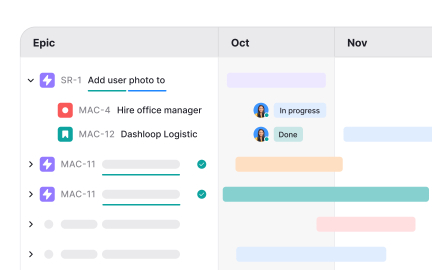Jira
Jira is a widely used tool for tracking tasks, sprints, and progress in agile development environments, supporting product and engineering teams.
What is Jira?
Your development team struggles with project coordination and progress tracking because work management happens through scattered emails and informal communication, leading to missed deadlines, duplicated effort, and lack of visibility into project status and resource allocation.
Most teams rely on informal project management without systematic tracking tools, missing opportunities to coordinate development work efficiently and provide stakeholders with clear visibility into progress, obstacles, and timeline expectations.
Jira is a project management and issue tracking software platform that enables development teams to plan, track, and coordinate work through systematic task management, progress visualization, and collaboration features designed specifically for software development and agile project management.
Teams using Jira effectively achieve 45% better project coordination, 35% improved deadline adherence, and significantly enhanced stakeholder communication because work is organized systematically rather than managed through informal processes that don't scale effectively.
Think about how successful software development teams use Jira to coordinate complex projects across multiple developers and stakeholders, or how product teams use issue tracking to manage feature development from conception through deployment and user feedback.
Why Jira Matters for Development Coordination
Your development projects lack systematic coordination because work tracking happens informally, leading to missed dependencies, unclear priorities, and stakeholder frustration when project status and timeline expectations aren't communicated effectively.
The cost of informal project management compounds through every coordination failure that could be prevented through systematic work tracking. You get missed deadlines, duplicated effort, unclear responsibilities, and stakeholder dissatisfaction when project visibility doesn't enable effective planning and resource allocation.
What effective Jira implementation delivers:
Better project visibility and progress tracking because systematic work tracking provides real-time visibility into project status, team capacity, and obstacle identification rather than guessing about project health and timeline accuracy.
When work is tracked systematically, project management becomes proactive rather than reactive to problems that could have been identified and addressed earlier with better visibility.
Enhanced team coordination and responsibility clarity through clear task assignment and dependency tracking that ensures team members understand their responsibilities and how their work connects to broader project objectives.
Improved stakeholder communication and expectation management because Jira provides transparent project reporting that keeps stakeholders informed about progress without requiring constant status meetings and manual updates.
Stronger development process improvement through work tracking data that reveals patterns in development velocity, obstacle frequency, and process bottlenecks that inform team optimization and resource allocation improvements.
More effective resource allocation and capacity planning as systematic work tracking enables accurate estimation and resource planning based on historical data rather than guessing about team capacity and project complexity.
Once you've established basic Jira capabilities, implement sophisticated project coordination and development optimization approaches.
Cross-Project Coordination and Portfolio Management: Use Jira to coordinate multiple related projects and strategic initiatives rather than just individual project tracking without portfolio visibility and resource optimization.
Advanced Automation and Workflow Optimization: Implement Jira automation that reduces administrative overhead while maintaining project visibility and coordination rather than manual tracking that consumes development time unnecessarily.
Integration with Development Tools and CI/CD: Connect Jira to development toolchain including code repositories, testing systems, and deployment pipelines rather than isolated project tracking without development workflow integration.
Agile Metrics and Performance Optimization: Use Jira data for advanced agile metrics including velocity tracking, cycle time analysis, and process improvement rather than just basic project reporting without development optimization insights.
Step 1: Configure Jira Projects and Workflow Structure (Week 1)
Set up project structures, issue types, and workflow stages that match your development process rather than using default configurations that might not serve your team's specific coordination needs and working patterns.
This creates Jira foundation based on actual development workflow rather than generic project management that might not enhance team coordination and productivity effectively for your specific context.
Step 2: Establish Issue Creation and Management Standards (Week 1-2)
Define consistent formats for creating issues including requirements documentation, acceptance criteria, and priority assessment rather than ad-hoc issue creation that might not provide development teams with information needed for effective execution.
Focus issue management on actionable information that enables development progress rather than comprehensive documentation that might not improve team productivity and coordination significantly.
Step 3: Implement Team Workflow and Sprint Planning Integration (Week 2)
Connect Jira to actual development work through sprint planning, daily standup coordination, and progress tracking that serves team coordination rather than just issue documentation without workflow integration.
Balance systematic tracking with development efficiency to ensure Jira enhances rather than interrupts development workflow and team productivity through excessive administrative overhead.
Step 4: Create Reporting and Dashboard Systems (Week 2-3)
Build project dashboards and reports that provide stakeholders with necessary project visibility while enabling team performance analysis and process improvement rather than just comprehensive data collection.
Step 5: Optimize Jira Usage Based on Team Performance and Feedback (Week 3)
Adjust Jira configuration and processes based on team experience and project outcomes rather than rigid tool usage that might not serve evolving team needs and project requirements effectively.
This ensures Jira implementation enhances team effectiveness rather than creating administrative overhead that doesn't improve development coordination and project success measurably.
If Jira usage doesn't improve team coordination, examine whether configuration matches actual development workflow rather than just comprehensive tracking that might not serve practical coordination needs.
The Problem: Jira configurations that become overly complex with excessive fields, workflows, and customizations that create administrative burden without proportional improvement in team coordination and productivity.
The Fix: Keep Jira configuration focused on essential coordination needs rather than comprehensive tracking that might not serve team effectiveness, ensuring tool complexity matches actual coordination requirements.
The Problem: Issue tracking that focuses on comprehensive documentation rather than actionable information that enables development progress and team coordination effectively.
The Fix: Create issue standards that provide development teams with information needed for execution rather than just comprehensive documentation that might not improve development effectiveness significantly.
The Problem: Jira usage that becomes bureaucratic overhead rather than coordination tool, with teams spending more time updating issues than coordinating work effectively.
The Fix: Balance tracking thoroughness with development efficiency, ensuring Jira serves coordination rather than creating administrative work that doesn't enhance team productivity and project success.
Create Jira approaches that enhance development coordination rather than just systematic tracking that might not improve team effectiveness and project outcomes meaningfully.
Recommended resources
Courses

HTML Foundations

Mentorship Mastery



